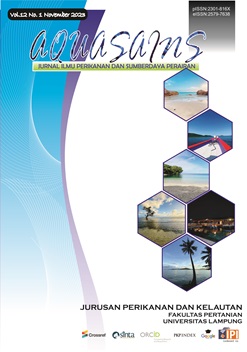SPATIAL AND TEMPORAL PATTERNS OF FISHING USING PAYANG NETS IN STARING BAY, SOUTH KONAWE DISTRICT
DOI:
https://doi.org/10.23960/aqs.v12i3.p1528-1537 Abstract View: 220
Abstract View: 220
Abstract
Staring Bay is a semi-open bay that has a relatively large potential for fishery resources, so it is widely used by fishermen in South Konawe Regency to carry out capture fisheries activities. One of the fishing gear operated by fishermen is payang fishing gear. This fishing gear is operated to catch small pelagic fish. The purpose of this study was to determine the spatial and temporal patterns of fishing with Payang fishing gear in the waters of Staring Bay, South Konawe Regency. The research was conducted from December to January 2022 in the waters of Staring Bay, South Konawe Regency. The analytical method consists of catch composition analysis, CPUE analysis, correlation and determination analysis. Based on the research results, it was found that the fish catch was directly proportional to the distance from the fishing area. The distance of the fishing area that is far from land is 5.50 miles with a catch of 450.00 kg/trip, while the distance of the fishing area that is close to land is 3.35 miles with a catch of 82.50 kg/trip. Apart from that, fishing time also influences catch results, where the highest catch occurs in January reaching 211.91 kg/trip and the lowest catch occurs in December reaching 12.66 kg/trip.
Keywords: Payang catch, spatial and temporal patterns, Staring Bay
Downloads
References
Azizi, A, Putri, E. I. K., & Fahrudin, A. (2017). Analisis faktor-faktor yang mempengaruhi perubahan pendapa-tan nelayan akibat variabilitas iklim (Kasus Desa Muara Kecamatan Blanakan, Kabupaten Subang). Jurnal Sosial Ekonomi Kelautan Perikanan, 12(2): 225-233.
Asruddin, & Nasriani. (2018). Perspektif Kekinian Efisiensi Teknis Pemasangan Rumpon. (Skripsi). Universitas Muhammadi-yah Gorontalo. Gorontalo.
Ayodhyoa, A. U. (1981). Metode Penangkapan Ikan. Yayasan Dewi Sri. Bogor. 97 hlm.
Badan Pusat Statistik Kabupaten Konawe Selatan. (2018). Kabupaten Konawe Selatan dalam Angka 2018. BPS Kabupaten Konawe Selatan. Nomor Publikasi: 74050.1803. Katalog: 1102001.7405.
Dewanti, R. O. N., Ghofar, A., & Saputra, S, W. (2014). Beberapa aspek biologi ikan teri (Stolephours devisi) yang ditangkap payang di perairan Kabupaten Pemalang. Diponegoro Journal of Maquares, 3(4): 102-111.
Harahap, A., Khalfianur, W., & Niati, C. R. (2017). Pengaruh gelombang laut terhadap hasil tangkapan di Kuala Langsa. Samudra Akuatika, 1(2): 21-25.
Hardiyanti, S., Yasidi, F., & Salwiyah. (2019). Studi kelimpahan dan keanekaragaman zooplankton di perairan Teluk Staring Desa Puasana Kecamatan Moramo Utara Kabupaten Konawe Selatan. Jurnal Manajemen Sumber Daya Perikanan, 4(3): 243-249.
Hasan. (2003). Pokok-pokok Materi Statistik Deskriptif, Edisi Kedua. PT Bumi Aksara. Jakarta.
Hikma, N., Kurnia, M., & Amir, F. (2016). Pemanfaatan teknologi alat bantu rumpon untuk penangkapan ikan di perairan Kabupaten Jeneponto. Jurnal IPTEKS PSP, 3(6): 455-468.
Kantun, W, Darris, L., & Arsana, W. S. (2018). Komposisi jenis dan ukuran ikan yang ditangkap pada rumpon dengan pancing ulur di Selat Makassar. Marine Fisheries. 9(2): 157-167.
Leavastu, T., & Hayes, M. (1970). Fisheries Oceanografy. Fishing News Ltd. London. 236 hlm.
Lagler, K. F., Bardach, J. E., Miller, R. H., & Passino, D. R. M. (1977). Ichthyology, 2nd Edition. John Wileyand Sons Inc. Toronto.
Mardijono. (2008). Persepsi dan Partisipasi Nelayan Terhadap Pengelolaan Wilayah Konservasi Laut Kota Batam. (Tesis). Universitas Diponegoro. Semarang.
Nasiru, W. O. A., Tadjuddah, M., & Mustafa, A. (2017). Distribusi suhu permukaan laut secara spasial dan temporal hubungannya dengan hasil tangkapan madidihang di perairan Wakatobi. Jurnal Manajemen Sumberdaya Perairan, 2(4): 307-316.
Purwaningtyas, S. E., Sugianti, Y., & Hartati, S. T. (2006). Hasil tangkapan ikan dengan menggunakan bubu di Teluk Saleh, Nusa Tenggara Barat. Prosiding Seminar Nasional Ikan IV: 255-264.
Prayitno, M. R. E., Simbolon, D., & Yusfiandayani, R. (2017). Produktivitas alat tangkap yang diopersikan di sekitar rumpon laut dalam. Marine Fisheries, 8(1): 101-112.
Purbayanto, A, Riyanto, M., & Fitri, A. D. P. (2010). Fisiologi dan Tingkah Laku Ikan pada Perikanan Tangkap. PT IPB Press. Bogor.
Picaulima, S. M, Wiyono, E. S., Baskoro, M.S., & Riyanto, M. (2021). Analisis faktor-faktor yang mempengaruhi hasil tangkapan dalam dinamika armada perikanan skala kecil di Pulau Kei Kecil bagian timur, Kepulauan Kei. Jurnal Sumberdaya Akuatik Indo-pasifik, 5(3): 415-428.
Putra, A.A, Asriyana, & Irawati, N. (2021). Biologi kebiasaan makan ikan kembung perempuan (Rastrelliger brachysoma) di perairan Teluk Staring Konawe Selatan Sulawesi Tenggara. Jurnal Manajemen Sumber Daya Perairan, 6(2): 119-130.
Riduwan. (2005). Dasar-dasar Statistika. CV. Alfabeta. Bandung.
Susaniati, W., Nelwan, A. E. P., & Kurnia, M. (2013). Produktivitas Daerah Penangkapan Ikan Bagan Tancap yang Berbeda Jarak dari Pantai di Perairan Kabupaten Jonepto. (Skripsi). Universitas Hasanuddin. Makasar.
Simbolon, D., Jeujanan, B., & Wiyono, E.S. (2011). Efektivitas pemanfataan rumpon pada operasi penangkapan ikan di perairan Kei Kecil, Maluku Tenggara. Marine Fisheries, 2(1): 19-28.
Simbolon, D., & Halim, A. (2006). Suhu permukaan laut kaitannya dengan hasil tangkapan ikan cakalang dan madidihang di perairan Sumatera Barat. Buletin PSP, 15(3): 122-138.
Wahyu, R. I., Sondita, M. F. A., Wisudo, S.H., & Haluan, J. (2008). Hasil tangkapan utama dan hasil tangkapan sampingan (bycatch) dari perikanan demersal trawl skala kecil di perairan utara Jawa Barat. Buletin PSP, 17(3): 306-314.
Zamdial, Muqsit, A., & Wulandari, U. (2020). Pemetaan daerah penangkapan ikan (fishing ground) nelayan Kota Bengkulu, Provinsi Bengkulu. Jurnal Enggano, 5(2): 205-218.

.png)










